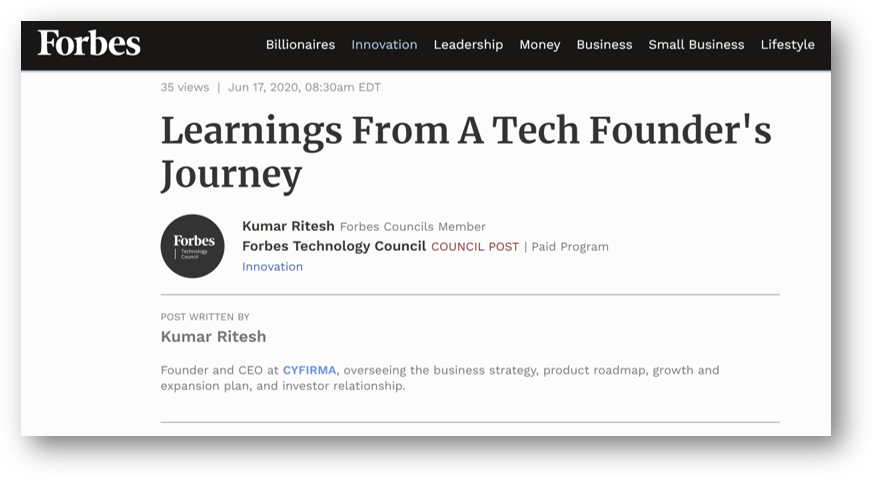



PUBLISHED IN FORBES ON 17 JUN 2020,
BY KUMAR RITESH
Put in charge of cybersecurity for one of the world’s largest mining conglomerates, I was in an enviable position with over a hundred security staff at my bidding, a multimillion-dollar technology budget to work with, and full command and control over cybersecurity strategy.
The state of cybersecurity was far from ideal, with security professionals struggling to keep up with cyberattacks. The more technology we introduced into the environment (cloud migrations, hyper-scalers, multicloud services, hyper-converged infrastructure, big data and analytics, artificial intelligence and machine learning, blockchain solutions), the more risk and exposure the organization would have to face. Adding more tools and security controls only serve to complicate matters; promises by vendors on the wonders of orchestration and automation remain elusive. My security team continued to sort through the quagmire in the avalanche of unknown threats, fighting an invisible enemy.
It was back in 2016 that it became clear to me the business world was looking at cybersecurity the wrong way. The navel-gazing method of security controls sends teams on nonstop tactical missions and misses the truly critical risk that could come from the outside. Guided by my experience leading a national cyber intelligence unit for close to a decade, I knew the solution was in blending the most appropriate security controls with advanced intelligence, and only then would we have truly ironclad security.
It has been more than three years since I started my journey as an entrepreneur, and the learnings have been nothing short of breath-taking. I’ll share my journey here, and hopefully you’ll be able to apply what I’ve learned to your own startup scenario.
The first two years are the most important period of any startup — survive that and then you can start talking about growth. As a new kid on the block, your company’s brand is synonymous with your personal brand. Investors, partners, employees and customers need to believe in you and your mission. You should focus on building this brand by raising money and then aim to bring people together and align them with your singular goal. Building a new business is a calling, and so is joining a startup. Once you have established your base, you need to transition quickly to become a formal business and start operating efficiently and effectively.
You are going to hear more negatives than positives. Some are well meaning; others are less so. Nonetheless, you are your most earnest cheerleader. Dig deep, and find the motivation the sets you on this course in the first place. Be stoic, and focus on executing your strategy, business plan and product development. Continue to work on improving your customer experience, striving to be the best in your category.
The journey to success is frequently long and arduous, not to mention lonely and exhausting. To stay on course, you need to find sparks of joy and celebrate key milestones because these will form the scaffolding as you continue to scale your mountain. I always advise new founders to stay true to their original big, hairy, audacious goals but pepper that with mini achievements. This way your energy is refilled often, which helps keep you on track toward your aspirations.
Things can move very quickly in a startup, often with minimal supervision and processes. Information sharing can be uneven, and this can result in misadventures and misunderstandings. To prevent any misguided outcomes, communicate, and communicate some more. Ensure all business functions are aligned to the overall objective yet clear on their respective deliverables.
A great company is built by a diverse and multitalented workforce. Accept the reality that you do not have answers to every problem — hence the importance of finding talent that complements you. Build a culture seeped in mutual respect. Embrace new thinking, and develop new problem-solving skills.
As the leader of your startup, you set the tone for the company and define what “good” looks like. You will set the bar high and be clear on your expectations, but you must also ensure all team members are cognizant of your core principles and know where you stand when it comes to driving results and outcomes. Hold your standards high, and make known that business ethics and integrity should always be nonnegotiable clauses.
As you continue to build your startup, add more customers, expand into new markets, gain fame and popularity, and maniacally focus on increasing valuation, don’t forget the importance of lateral growth. Lateral growth is defined by iterating on your product to ensure it addresses the needs of your market, and this calls for continuous innovation, no matter how and where you choose to pivot. Lateral growth is driven by innovation, culture and people, and it should always accompany you at every stage of your journey. I refer to these adjacent elements as essentials for sustainable and meaningful growth.
I’d leave you with this adage: If you want to go fast, go alone. If you want to go far, go together. Building a startup will test you on many fronts, but if you can harness the talents around you, you will be a step closer to realizing your vision.